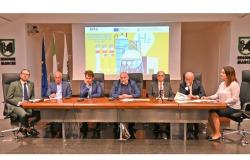In recent days, the national press – taken up and detailed by the local press also for Molise and Abruzzo – has reported the conclusions and data of a study conducted by the “Water Value for Italy” Community.
The Community, as is known, involves all the key players in the Italian water supply chain: operators of the integrated water cycle, representatives of the world of agriculture, technology and software providers, suppliers of machinery and systems as well as national and international institutions. European reference countries; this, for the purposes of a permanent comparison regarding the management of water resources and the effects of climate change.
By virtue of the investigations conducted, “Water Value for Italy” unfortunately had to conclude that: 12 regions, including Molise and Abruzzo, suffer from “high water stress”; another 4 of “medium stress” while Friuli Venezia Giulia, Veneto, Lombardy and Trentino Alto Adige are subject – at the moment – to “low” stress.
The drought – states the Community – has reached worrying levels so much so that in Italy, in one year (detection at the end of 2022), a 51.5% loss of renewable water resources was recorded compared to the historical average since 1950. Agriculture and hydroelectric are the sectors most affected by global warming and drought and, for the latter, the ability to satisfy energy demand is significantly compromised.
In particular, “Valore Acqua per l’Italia” reports, «… total rainfall has drastically decreased and the snow cover has recorded a deficit of 60% compared to the average for the decade 2010-2021. Due to the high temperatures, only 13.5% of the rainfall contributed to aquifer recharge. This phenomenon raises further concern as it is expected that renewable water resources will further reduce by 40% by 2100, with peak reductions of 90% in southern Italy.”
As far as our region is concerned, saying that Molise is a region rich in water is now a stereotype that no longer corresponds to reality. In fact, even on our mountains, already famous for their abundant snowfall, last winter it almost didn’t snow and the rather scarce spring rains did not make up for it in any way.
Molise Acque found «… a decline in the supply of deep springs and even more so in superficial ones…» noting that «… the shortage of spring water, in cascade, will become a shortage in municipal tanks…». The Liscione dam, still in June, for example, is already one and a half meters below the maximum level; the Occhito reservoir is half full compared to 2023; its availability is, to date, 50% of that recorded in the same period last year, when it was 240 million meters of water compared to the current 127.
In essence, in the words of meteorologist Gianfranco Spensieri, the water crisis in Molise is full: «There are almost 120 million (practically 50% less) fewer cubic meters compared to the same period last year».
From Campania, a region to which Molise supplies water, there is an excessive demand; Molise Acque has announced night closures to the Prefectures of Benevento and Avellino which, in the short term, will not be an abstract hypothesis but a necessity also for our region. To raise the water level in the tanks or limit its lowering, preparatory technical checks are being carried out in recent days, also considering the possibility of resolutions to be taken “in agreement with the mayors”; Furthermore, the possibility of reactivating the water purification plant downstream of the Liscione Dam is envisaged.
If Molise is thirsty, Abruzzo is not much better off, also – as mentioned – included among the 12 regions with “high water stress”.
Indeed, just to stay close to us and with reference to the most recent press news (June 19th) it is Pettorano sul Gizio, in the Peligna Valley, that has adopted restrictive measures regarding the use of water. The mayor has in fact issued an ordinance to prohibit the use of drinking water to irrigate vegetable gardens, private gardens and wash vehicles, allowing it exclusively for domestic, hygienic and zootechnical uses; and this, with the invitation addressed to all citizens to report any waste or improper use of drinking water for the application of the relative pecuniary sanctions.
In this context (and with these perspectives) what meaning does the “Pizzone II” project have? Five years of construction sites (in Enel’s optimistic forecasts) with the relevant deeply invasive works, would devastate one of the most beautiful areas of the Abruzzo, Lazio and Molise National Park: a territory that today is strictly protected for its precious integrity; furthermore, a vocation for tourism development based on valuable biodiversity in a landscape of rare purity would be cynically denied; furthermore, a definitive acceleration would be given to a depopulation without any more hope. All of this, for the sole purpose of spending half a billion euros on megastructures that are likely to be destined for nothing in a short time, not only due to a foreseeable technological development that would favor different and more convenient sources of energy but certainly due to the insufficiency of water : raw material that would be disputed between hydroelectricity and the needs of the population for an area that drought will make increasingly larger!!!
The populations of Alto Sangro and Alto Volturno, organized in the “Coordinamento No Pizzone II” and supported by the “Terra Sancti Vincentii” Association, by the WWF Molise as well as by other groups, have raised and continue to raise their clear voice of opposition to the ‘absurd project.
The same cannot be said for the institutions and, in particular, for those in Molise. The institutions themselves, in fact, would have the obligation to be far-sighted and timely, intervening well before the horses have escaped from the stable, thus avoiding being reduced to uselessly chasing emergencies that are no longer manageable and ending up, consequently, with abandoning itself the population they were supposed to govern.
To institutions of this type, heroic exceptions are made by two Abruzzo administrations directly involved in the project: the municipalities of Barrea and that of Alfedena, as well as a third – from Molise – although not directly affected by the works: the municipality of Rocchetta a Volturno. Totally alone in the region, Rocchetta took on the burden (of the attempt) to safeguard the upper Volturno Valley. Unfortunately, in fact, in the two Molise municipalities directly affected by the devastation, a mayor – openly assuming the related responsibilities for a clearly wrong choice – nevertheless clearly expressed his support for the project; the leadership of the other Municipality, while waiting to know the definitive massacre, has taken a position of possibility and, therefore, of substantial openness to the possibility of seeing its territory violated – figuratively and materially (an area, in fact, loses its integrity regardless of the percentage of corruption and degradation that is inoculated into it: a percentage which, in any case, would always be too high).
But if – in some cases – small municipalities find themselves faced with problems that are difficult for their mayors to categorize, with not as much indulgence we can understand the attitude of regional administrators, whose CVs would often acknowledge the possession of a very different adequacy of evaluation and vision. Therefore, the softness shown towards the project by the Molise government is completely surprising.
What is certain is that in the authorization process envisaged for the “Pizzone II” project, the factor of climate change must be taken into absolute consideration, leaving the bar straight towards the interests of the population of Alto Sangro and Alto Volturno. The risk of sacrificing a territory, its population and huge resources for nothing is maximum and concrete.
It would therefore be absolutely desirable that the local and regional administrations, in order to better direct their actions, took advantage of the opportunity offered on Friday 28 June in the Schuster room of the Abbey of San Vincenzo al Volturno. In the aforementioned venue, in fact, at 6.00 pm, the topic will be the subject of a meeting with the population. Air Force General Elia Rubino, meteorological expert, will illustrate the phenomenon of climate change, Dr. Aldo di Benedetto, mayor of Barrea and former director of the Abruzzo, Lazio and Molise National Park, will take stock of the water resources of the territory interested in the project and, finally, Prof Nanni Piacentino, a well-known and illustrious physicist from Campobassa, will broaden the horizon, beyond hydroelectric, to other sources of clean energy.
Gian Carlo Pozzo
Print Article





